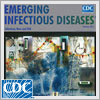Oseltamivir-Resistant Flu
[Announcer] This program is presented by the Centers for Disease Control and Prevention.
[Maureen Marshall] Hi, I’m Maureen Marshall and today I’m talking with Dr. Aaron Storms, an EIS officer specializing in influenza at CDC. Our conversation is based on his paper about oseltamivir-resistant H1N1flu, which appears in CDC's journal, Emerging Infectious Diseases. Welcome, Dr. Storms.
[Aaron Storms] Thank you, I’m happy to be here.
[Maureen Marshall] Dr. Storms, what is oseltamivir?
[Aaron Storms] Oseltamivir—which is also known by its trade name, Tamiflu— is an antiviral medicine that can treat flu illness. Specifically, it works by blocking proteins called “neuraminidase,” which are located on the surface of flu viruses and play an important role in how these viruses cause infection. You see, when a flu virus invades a healthy cell, it tricks the cell into making copies of itself. These duplicate flu viruses then attempt to escape the infected cell to invade and infect other healthy cells. Neuraminidase are the proteins that allow flu viruses to escape infected cells, and for that reason, antiviral drugs that block neuraminidase proteins, like oseltamivir, help to limit further infection.
[Maureen Marshall] What does it mean for a virus to be oseltamivir-resistant?
[Aaron Storms] So, the first concept is that flu viruses can become resistant to antiviral medications, and antiviral resistance means that a virus has changed in such a way that the antiviral drug isn’t effective or is less effective. We determine whether a virus is oseltamivir-resistant in the laboratory. And in the lab test, if oseltamivir doesn’t inhibit the function of the neuraminidase protein, we call the virus oseltamivir-resistant. The 2009 pandemic H1N1 viruses that are resistant to oseltamivir have a genetic change that changes their neuraminidase.
[Maureen Marshall] How do flu viruses become resistant to antiviral drugs designed to treat them?
[Aaron Storms] Resistance of influenza A viruses to antiviral drugs can occur spontaneously or it can emerge during the course of antiviral treatment. For example, when a person who’s infected with the flu is treated with oseltamivir, the viruses in that person’s body may find ways to avoid the drug. Also, there have been people who get infected with oseltamivir-resistant influenza viruses despite never having received oseltamivir in the past. Flu viruses are constantly undergoing genetic changes and the changes that make a virus resistant can occur without exposure to an antiviral drug.
[Maureen Marshall] In your article, you discuss the oseltamivir resistance trends in pandemic influenza A (H1N1) and seasonal influenza A (H1N1). Tell us more about those trends.
[Aaron Storms] Well, before pandemic H1N1 emerged in 2009, a virus called seasonal influenza A (H1N1) circulated widely throughout the world. Before the 2007–2008 flu season, less than one percent of these seasonal H1N(1) viruses had been identified as oseltamivir-resistant. However, by the 2008–2009 season, more than 95 percent of these viruses were resistant. This was a marked increase over a short period of time, and the resistance was conferred by a specific genetic change called H275Y substitution. Currently, oseltamivir resistance is rare in pandemic H1N1 viruses. However, when identified, the resistant pandemic viruses have the same genetic change we saw in the resistant seasonal H1N1 viruses: the H275Y substitution. During the pandemic, almost all of the oseltamivir-resistant pandemic H1N1 viruses appeared to occur during antiviral treatment. In contrast, last year, most of the pandemic H1N1 viruses with resistance didn’t come from people who had previously been treated with oseltamivir. This means that some oseltamivir-resistant viruses are circulating in the community at a very low level. Therefore, CDC monitors these viruses closely for any signs of an increase in the proportion of resistant viruses.
[Maureen Marshall] What do these trends mean for flu treatments?
[Aaron Storms] For now, the levels of oseltamivir resistance in pandemic H1N1 remain very low, so the recommendations for the use of oseltamivir or zanamivir, another antiviral drug that can be used to treat flu, remain unchanged. Treatment with a flu antiviral drug is recommended for patients who are hospitalized or have severe or progressive illness due to confirmed or suspected flu infection. Treatment is also recommended for patients who have higher risk of developing flu complications, as is the case of young children, the elderly, or people with certain medical conditions.
[Maureen Marshall] Is there anything we can do to stop the increasing resistance to oseltamivir?
[Aaron Storms] Most of (the) oseltamivir resistance that we’re finding in pandemic H1N1 viruses is not associated with drug use. Scientists around the world are trying to understand why resistant viruses might become more common and what factors play a role when resistant viruses replace susceptible viruses. In the meanwhile, we’re closely monitoring these viruses globally for any sign of an increase in antiviral resistance. The development of new antiviral medications is another step health researchers are taking to address antiviral resistance. New antiviral drugs that target a different virus protein than neuraminidase would be helpful also.
[Maureen Marshall] What roles do vaccines play in treating or preventing the flu?
[Aaron Storms] The flu vaccine plays a role in prevention, as it’s the first and most important step to protect ourselves against the flu. The vaccine is effective against both oseltamivir-susceptible and -resistant pandemic H1N1 viruses. As of the 2010–2011 flu season, CDC recommends that every person aged six months and older should receive the flu vaccine every year to prevent getting the flu.
[Maureen Marshall] Thanks, Dr. Storms. I’ve been talking with Dr. Aaron Storms about his paper, Oseltamivir-Resistant Pandemic (H1N1) 2009 Virus Infections, United States, 2010-11, which appears in the February 2012 issue of CDC's journal, Emerging Infectious Diseases. You can see the entire article online at www.cdc.gov/eid.
If you’d like to comment on this podcast, please send an email to eideditor@cdc.gov. I’m Maureen Marshall, for Emerging Infectious Diseases.
p>
[Announcer] For the most accurate health information, visit www.cdc.gov or call 1-800-CDC-INFO.



